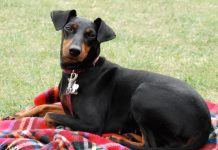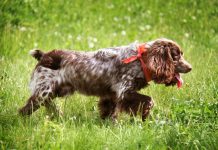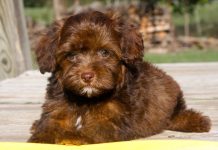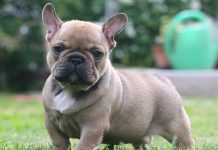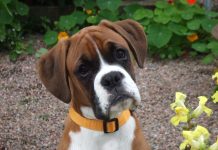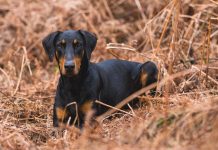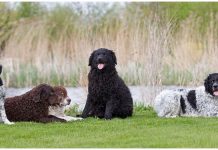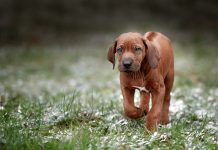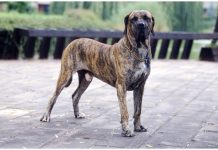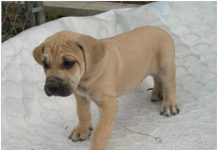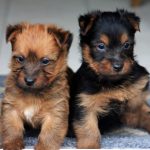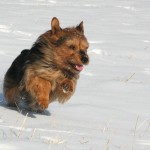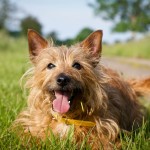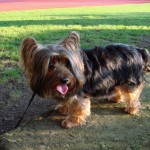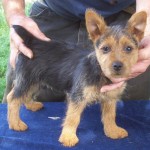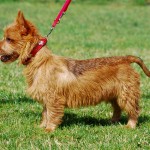Because of their high intelligence, ability to grasp things quickly, and willingness to learn they are very easy to train. Be careful, however, with what you teach them; you do not want them to pick up life-long bad habits. Even with training, though, they may be prone to chase after cats and other small animals.
History and Health :
- History :
The Australian Terrier is most likely a descendant of the Rough-Coated Terrier along with other British Terriers, such as the Dandie Dinmont Terrier, the Skye, the Yorkshire, and the Black and Tan Terrier, that were brought to Australia from Britain. These dogs were bred in Australia to produce a hardy, courageous dog that could work in all types of conditions and weather. The Australian Terrier was the result, and were used to control and exterminate rats and snakes; and as shepherds, watchdogs and companions to people and families. The Aussie is the first native breed in Australia, and was officially named in 1892. It was introduced back to its historical home of England shortly before 1933, and after World War II, it found its way to the United States.
- Health :
They commonly suffer from diabetes, allergic dermatitis, luxating patella and ruptured cranial cruciate ligament. Less commonly, they have cataracts and ear infections. They are genetically prone to having luxating patella (see above), legg-perthes (a deformity of the hip), diabetes, and various allergies including food allergies, contact allergies (such as flea powders, dog shampoos, or other chemicals) and airborne allergens (such as dust, pollen and mildew). Two out of every three Australian Terriers die from cancer, and the rest die from old age, diabetes or from unknown causes.
Temperament & Personality :
- Personality :
They are described as being spirited, mischievous, upbeat, active, silly, alert, courageous, even-tempered, loyal, and a good companion. Other applicable descriptors are tenacious, independent and hard-working.
- Activity Requirements :
They may be small, and thus good for apartments, but they do need to be active. If you have a fenced-in yard then that may be ideal. However, do not leave him out on his own because as a result of his mischievous nature, he may dig up your plants and to chase after your other pets.
- Trainability :
They are above-average in being trained, and they must be trained well in case they encounter other pets.
- Behavioral Traits :
Perhaps the overwhelming characteristic is that they are playful and fun-loving. In this regard, he loves playing with children and following you around the house. They are devoted to the family and want to be a part of it. They are quite energetic so you ought to keep up with them, and not to bore them. They may be small but they have the confidence of large animals.
Appearance & Grooming :
- Appearance :
They are small (in fact, they are the smallest of the working Terriers) and have a somewhat shaggy and rough coat.
- Size and Weight :
Both male and female dogs are 9 to 11 inches (23 to 28 cm) in height and they generally weigh 14.1-16 lbs (6.4-7.3 kg), although females may be 1 lb (2.2 kg) lighter. More precisely, the average height is 9.8 inches (25 cm) and the average weight is 14 lbs (6.5 kg).
- Coat & Color :
The outer coat is rough and shaggy, but the inner coat is soft. The coat is thickest and longest on the chest and head. They are red, sandy, or a combination of tan and blue. There can be patches of black.
- Grooming :
Grooming is easy to achieve as the dogs shed only a small amount. Brushing weekly, trimming the toenails monthly and bathing once every three months is all that is needed. Perhaps counter-intuitively, you should not bathe the dog frequently if you are going to enter him in a show. Bathing will soften the coarse coat and can cost points in a show.
- Body Type :
Their body is that of the Small dogs group, and they do tend to be slim.
Characteristics :
- They are good with children, and will be even better with training, which is especially needed when the Australian Terrier is around very young children.
- Even with good training, they may not be desirable around cats.
- They are usually not good around other dogs.
- Training them is usually quite easy.
- They shed rarely and minimally.
- Because of their alertness and loyalty, they make excellent watchdogs.
- They are above average in intelligence.
- It is quite easy to groom and maintain them.
- They are above average in popularity.
- They were bred in Australia to be adaptable, and they continue to be that way.
- They are hypoallergenic.
Tasty Tidbits :
Their most common activities are barking, digging and chasing, which is not always pleasant. Their personality may be best summed up as being “bossy”.
Care :
These dogs are active and will appreciate a daily walk or supervised time in a yard. They are naturally very fun-loving and playful, so they can entertain themselves but it is better when they interact with people.
Images, Pics, Photos and Pictures of Australian Terrier :
Feeding :
They are not fussy eaters, have a healthy appetite, and are very active, but they do not usually overeat. Because of their common allergies, it may be a good idea to avoid cereals, red meat and other allergens. Because they can develop diabetes, treats should also be avoided, or kept to a minimum.
Information and Facts of Australian Terrier :
- The dog’s official name is Australian Terrier
- Its nickname is Aussie
- The Aussie originated, of course, in Australia (specifically, Tasmania)
- It belongs to the Small Dog breed of dogs
- Kennel clubs classify it as being a Terrier
- The lifespan is 12 to 15 years, although purebred dogs may be on the low end of this range
- Both male and female dogs are 9 to 11 inches (23 to 28 cm) in height
- They generally weigh 14.1-16 lbs (6.4-7.3 kg), although females may be 1 lb (2.2 kg) lighter
- The colors are red, sand, blue or tan, often with patches of black
- In the U.S., Aussies range from $600-900; in the U.K., one is offered for £650 (USD1,094)
- They sleep for an average amount of time
- They are descended, most likely, from the Rough-Coated terrier
Also Read: McDonald's Positions Available: Learn How to Apply

